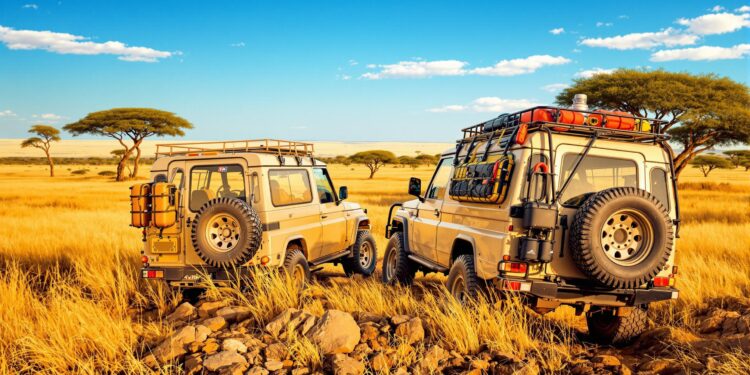Off-road driving in Kenya offers thrilling experiences but comes with risks. Here’s how to stay safe and prepared:
- Prepare Your Vehicle: Check tires, brakes, fluids, and suspension. Equip with essential tools like a high-lift jack, winch, and recovery boards.
- Master Terrain Techniques: Adjust tire pressure for sand, mud, or rocks. Use 4×4 modes correctly and practice uphill/downhill driving.
- Emergency Readiness: Carry communication tools (satellite phone, GPS), a first aid kit, and survival essentials like water filters and emergency blankets.
- Respect Wildlife and Laws: Stick to marked routes, maintain safe distances from animals, and secure permits for protected areas.
Quick Tip: Mechanical failures cause 35% of off-road incidents. Proper preparation reduces risks by up to 65%. Ready to dive deeper? Let’s explore the details!
4×4 Expedition Vehicle Preparation Advice & Tips
Preparing Your Vehicle for Off-Roading
Getting your vehicle ready for Kenya’s tough terrains takes careful planning. These steps focus on the unique challenges you’ll encounter, from the muddy trails of Masai Mara to the rocky paths of Hell’s Gate.
Pre-Trip Vehicle Checks
Begin by checking your vehicle’s fluids, especially the coolant, which is crucial in Kenya’s hot climate. Then, inspect these systems carefully:
| System | Check Points | Recommended Action |
|---|---|---|
| Tires | Pressure, tread depth, sidewalls | Adjust pressure (20-25 PSI for sand/mud) |
| Brakes | Pads, rotors, fluid | Replace pads if less than 50% remains |
| Suspension | Shocks, springs, bushings | Listen for unusual noises or movements |
| Electrical | Battery, connections, lights | Clean terminals and secure all connections |
| Fluids | Oil, coolant, brake fluid | Top off with high-quality fluids |
"Proper vehicle preparation is not just about performance; it’s about safety and environmental responsibility in Kenya’s delicate ecosystems." – David Kimani, Head of Vehicle Operations, Kenya Wildlife Service
Vehicle Modifications for Off-Road
To tackle water crossings in areas like Meru National Park, install a snorkel system to protect your engine from water damage. Extending differential breathers is another must for these conditions.
For rocky terrains, such as those in Hell’s Gate National Park, skid plates are essential to protect your vehicle’s underside. A modest suspension lift (2-3 inches) can provide better ground clearance, but don’t overdo it – balance is key for handling different terrains effectively.
Essential Off-Road Gear and Tools
Equip yourself with the right tools and gear to handle emergencies. Your recovery kit should include:
- Recovery Equipment: Heavy-duty tow straps rated for at least twice your vehicle’s weight
- Navigation Tools: A GPS device with offline maps
- Emergency Supplies: A well-stocked first aid kit
Additionally, these tools are indispensable:
| Essential Tool | Primary Use |
|---|---|
| High-lift jack | Vehicle recovery |
| Air compressor | Adjusting tire pressure |
| Recovery boards | Gaining traction in mud/sand |
| Winch | Pulling your vehicle to safety |
| Tool kit | Basic repairs and adjustments |
For reliable communication, carry a satellite phone and a CB radio, as recommended by NTSA‘s emergency response guidelines.
Once your vehicle is ready, the next step is learning how to handle the terrain effectively – an essential skill for safe off-roading.
Off-Road Driving Techniques
Knowing how to handle off-road conditions is essential for navigating Kenya’s diverse landscapes safely while reducing your impact on nature. Each type of terrain requires a specific approach.
Handling Different Terrains
Kenya’s landscapes vary widely, so your driving techniques need to match the conditions. For muddy roads, keep a steady pace of 5-10 km/h and use 4WD low range. Avoid sudden movements to maintain traction.
In sandy areas like the Chalbi Desert, managing tire pressure is key:
| Terrain Type | Recommended PSI | Speed Range |
|---|---|---|
| Sand | 15-20 PSI | 20-30 km/h |
| Mud | 20-25 PSI | 5-10 km/h |
| Rocky | 28-32 PSI | 5-15 km/h |
Adjusting tire pressure works best when paired with the correct use of your 4×4 system.
For water crossings, use the snorkel installation tips from earlier. Here’s what to do:
- Walk through the crossing first to check depth and obstacles (most 4x4s can handle up to 800mm of water).
- Enter at a 45° angle and drive at 5-7 km/h to create a protective bow wave.
- Keep the throttle steady to avoid stalling.
Using 4×4 Systems
Your 4×4 system is your best friend in tough conditions, but knowing when to use each mode is critical:
| 4×4 Mode | Best For | Max Speed |
|---|---|---|
| High Range | Gravel roads, light mud | Up to 60-80 km/h |
| Low Range | Deep mud, steep inclines | Below 40 km/h |
| Diff Lock | Extreme wheel-spin situations | 5-10 km/h |
Uphill and Downhill Driving
Kenya’s steep areas, like the Aberdare Ranges, demand careful driving. For uphill climbs:
- Choose your gear before starting the climb.
- Keep a steady throttle at 5-10 km/h.
- Avoid shifting gears mid-climb.
- Aim to keep your wheels on high ground.
For downhill descents:
- Use engine braking in low range.
- Maintain a slow speed of 5-10 km/h.
- Avoid using the clutch.
- Keep your steering straight.
Having a spotter can make a big difference. They can guide your wheel placement and alert you to obstacles, helping you avoid damage.
Take extra care on black cotton soil during the wet season. Use your recovery gear and maintain steady momentum at 5-7 km/h. These techniques not only ensure safe travel but also promote responsible driving practices in challenging environments.
sbb-itb-e5ed0ed
Emergency and Safety Procedures
When off-roading in Kenya’s remote areas, being prepared for emergencies can make all the difference. Having the right tools, knowledge, and mindset helps you handle unexpected situations effectively.
Communication Tools for Off-Roading
Staying connected in remote areas is essential. Here are some recommended communication devices:
| Device Type | Recommended Model | Key Features |
|---|---|---|
| Satellite Phone | Iridium | Global coverage, weather-resistant |
| Two-way Radio | Motorola T82 Extreme | Waterproof |
| GPS Device | Garmin GPSMAP 66i | Satellite messaging, location sharing |
| Emergency Beacon | ACR ResQLink 400 | Direct SOS to emergency responders |
These devices, paired with your recovery gear, create a comprehensive safety setup. The What3Words app is also a game-changer for emergency response in Kenya, cutting response times in remote areas by 30% since 2022.
First Aid and Survival Kits
Your first aid and survival kits should address Kenya’s specific challenges, such as wildlife, extreme heat, and isolation:
| Category | Essentials | Use |
|---|---|---|
| Medical | Rehydration salts, malaria treatment, snake bite kit | For location-specific emergencies |
| Basic First Aid | Bandages, antiseptic wipes, burn gel | Treating common injuries |
| Survival | LifeStraw filter, emergency blanket, high-energy food | For 72-hour survival situations |
"Proper preparation and the right emergency equipment can mean the difference between a minor setback and a life-threatening situation when off-roading in Kenya’s remote areas." – John Mutua, Off-Road Driving Academy Kenya
Handling Breakdowns and Getting Stuck
When your vehicle breaks down or gets stuck, follow these steps to stay safe and resolve the issue:
1. Initial Assessment
Stay calm. Use your GPS to determine your location and identify any immediate risks, such as nearby wildlife.
2. Contact Emergency Services
Have these numbers ready:
- Kenya Wildlife Service: +254 (0) 20 2379407
- Flying Doctors Service: +254 (0) 20 6992299
- AAK Road Rescue: +254 (0) 20 2715 368
3. Vehicle Recovery
Use synthetic winch ropes instead of steel cables – they’re safer and easier to handle. Maintain a safe distance of at least 1.5 times the length of the recovery straps during operations.
If you need to set up an emergency camp, choose elevated ground far from wildlife activity.
Legal and Environmental Considerations
Once you’ve mastered emergency protocols, it’s time to focus on legal responsibilities and protecting the environment. Following the NTSA’s emergency response guidelines not only ensures safety but also helps safeguard Kenya’s ecosystems.
Protecting Wildlife and Habitats
Kenya’s Wildlife Conservation Act (2013) emphasizes the importance of keeping a safe distance from wildlife:
- Stay at least 20 meters away from most wildlife.
- Maintain 50 meters from elephants and rhinos.
- Keep 100 meters away from predators with cubs.
| Protected Area | Key Rules | Seasonal Notes |
|---|---|---|
| Masai Mara | Use designated tracks only, max speed 40 km/h | Be extra cautious during migration (July–October) |
| Amboseli | Avoid driving through wetlands | Stay clear of swamps during the rainy season |
| Tsavo | Stop completely for elephants | Access may be restricted during rains |
"Off-road driving, when done responsibly, can provide unique wildlife viewing opportunities. However, it’s crucial to balance this with conservation efforts to protect Kenya’s delicate ecosystems." – Dr. John Waithaka, Former Chairman, Kenya Wildlife Service
Off-Roading Regulations in Kenya
The Kenya Wildlife Service (KWS) enforces strict rules to protect wildlife and their habitats. Violations can lead to fines of up to KES 200,000 or imprisonment for up to two years. Make sure you have the necessary permits, such as:
- KWS entry permits for national parks.
- Permissions from community conservancies.
Responsible Off-Roading Practices
Using equipment like snorkel systems and recovery gear responsibly can help reduce environmental harm. Here are some key practices to follow:
- Stick to marked routes to prevent habitat destruction.
- Carry out all your waste and dispose of it properly.
- Bury biodegradable waste at least 200 meters from water sources and 15 cm deep.
- Use KWS monitoring apps to report wildlife sightings.
- Report illegal activities to authorities.
- Contribute to local conservation funds.
Being mindful of these guidelines ensures you’re prepared to handle Kenya’s off-road challenges while respecting its natural beauty and wildlife.
Common Off-Road Challenges and Solutions
Even with careful preparation, Kenya’s rugged terrain presents unique challenges for off-road drivers. Here’s a breakdown of common obstacles and how to tackle them:
| Challenge | Technique | Equipment | Safety Tips |
|---|---|---|---|
| River Crossings | Enter at 5-7 km/h to create a bow wave | Snorkel system, depth stick | Avoid crossing if water is above wheel centers |
| Rocky Terrain | Use crawl speed, place wheels on rocks carefully | Rock sliders, skid plates | Use a spotter whenever possible |
| Steep Inclines | Maintain a 30-degree approach angle, use low-range gears | Hi-lift jack, tow rope | Never cross slopes sideways |
| Deep Sand | Drive at a steady 20-30 km/h, lower tire pressure to 15-20 PSI | Air compressor, sand ladders | Make wide, gentle turns |
According to the National Transport and Safety Authority (NTSA), mechanical failures account for 35% of off-road incidents. If your vehicle breaks down, prioritize safety over trying to push forward.
"The key to successful off-roading in Kenya is preparation. Know your vehicle, know the terrain, and always have a plan B." – John Kamau, Head Instructor, Kenya Off-Road Driving Academy
Clear communication is critical, especially in emergencies. Use the tools mentioned earlier to stay connected and follow a recovery process: start with traction aids, then use a winch if needed, and only seek external help as a last resort. If you’re using a winch, always protect tree trunks to avoid causing damage.
Weather can change quickly, so stay updated using Kenya Wildlife Service (KWS) alerts. Flash floods can turn dry riverbeds into dangerous crossings in minutes. Tracking rainfall patterns can help you avoid these hazards.
The best way to handle off-road challenges is to prevent them in the first place. Always check the weather and research your route before setting out. A little preparation goes a long way in keeping your adventure safe and enjoyable.
Conclusion
Off-road safety in Kenya depends on a mix of solid vehicle preparation, smart driving techniques, and well-thought-out emergency protocols. According to NTSA data, these strategies can cut incident risks by 65%.
Mechanical failures account for 35% of off-road incidents, as highlighted by the NTSA. Addressing this through proper training and strict adherence to safety measures is key to avoiding accidents and enjoying a smooth off-road adventure.
"The key to successful off-roading in Kenya is preparation. Know your vehicle, know the terrain, and always have a plan B." – John Kamau, Head Instructor, Kenya Off-Road Driving Academy
Preparing your vehicle and practicing safe driving (as discussed in sections 2-4) also helps protect Kenya’s natural environment. By focusing on proper equipment maintenance, recovery techniques, and safety measures, drivers can reduce their impact on the terrain and wildlife.
Navigating Kenya’s rugged landscapes demands constant awareness and readiness. Following the right safety practices is essential for every off-road enthusiast.
Related Blog Posts
- 10 Weekend Road Trip Routes from Nairobi
- FAQ: Importing Used Cars to Kenya in 2025
- 7 Tips for Rainy Season Car Care in Kenya
- Ultimate Guide to Car Maintenance Budgeting in Kenya




